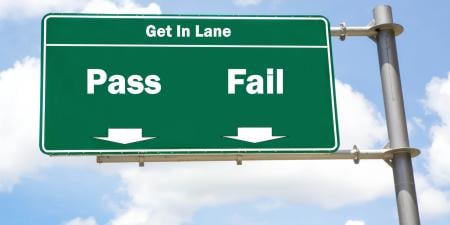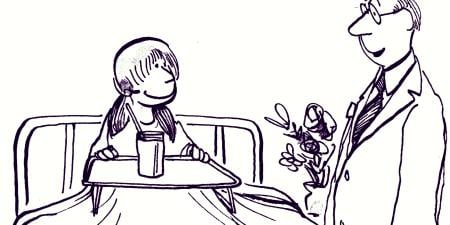It’s 5:30 a.m., and you are prerounding after a sleepless night on call. The first chart you pick up belongs to Mrs. M, a 93-year-old woman with dementia brought in by her family for persistent low-grade fevers. All tests are negative so far, and your team is planning an aggressive workup—they are discussing a temporal-artery biopsy then a bone-marrow biopsy. Next is Mr. N, 74, who was diagnosed with idiopathic pulmonary fibrosis in Kenya and came to the United States to get a second opinion. His shortness of breath has worsened. Social work is planning a rehab placement for him because he does not have insurance to pay for oxygen at home. Then there is Mr. C. Forty-three and homeless, with a long history of schizophrenia, Mr. C was admitted for prostatitis secondary to a wound to the rectum self-inflicted with a TV antenna. As you rush to each room in between returning pages and typing orders, you wonder, am I really helping my patients? What can I really do assist Mrs. M with her severe dementia, Mr. N with his terminal diagnosis, and Mr. C with his self-abuse? Has my medical education trained me for this?
This being an article about the “extra-medical” curriculum—what the physician-in-training learns outside of medical school—you might expect me to decry House-of-God cynicism because of my extra-medical experiences and to applaud the physicians who pursue training outside of medicine, as the numbers of “triple letter” joint programs such as MBA, MPH, MPP, and MHA multiply. After all, I took 4 years during and after medical school to get my own three-lettered degrees, to do international work, and to lead the American Medical Student Association (AMSA), whose motto, in fact, is “It takes more than medical school to make a physician” [1]. I could say that our health care system made me more sympathetic to its failures in assisting the homeless and mentally ill like Mr. C. I could discuss how being a journalist in East Africa enabled me to better connect with Mrs. M and empathize with Mr. N.
No doubt such extra-medical experiences aid in personal and career development; I am a more well-rounded individual with a better sense of career purpose because of the diverse experiences I’ve sought. But do we really need for all doctors to be trained in these other pursuits, in business, policy, administration, history, or journalism? Does it really take more than medical school to make a good doctor, to treat Mrs. M, Mr. N, and Mr. C? In this essay, I argue that, while it is paramount to have a comprehensive medical education curriculum that integrates ethics, public health, and professionalism, additional specialized training is not necessary. Due to medicine’s highly specialized nature, the critical shortage of physicians, and the increasing focus on incorporating professionalism into medical training, our doctor’s degree in medicine or osteopathy, should be enough to enable us to fulfill our social contract as physicians and deliver the best care possible to our patients.
Since Hippocrates’ time, medicine has been recognized as a specialized field with key skills and core competencies. Specialization is not inherently a negative thing. Indeed, society expects special expertise of physicians, just as it does of specialists in a variety of other fields. While it makes for more interesting conversation for, say, a pilot to converse about the business model of his airline, and a real estate agent to debate federal environmental laws, it’s far more critical for the pilot to know how to fly a plane and the real estate agent to apply local housing regulations. A physician with a JD or MPP is probably a more interesting person, but his or her critical skills as a physician are the clinical skills acquired in medical training. In the United Kingdom and South Africa, where undergraduate education and medical school are combined in a 6-year endeavor, nobody understood why I was pursuing graduate study in economics and policy—wasn’t I already a doctor? While this thinking struck me initially as being parochial and narrow-minded, the early specialization and lack of extra-medical curriculum in the United Kingdom (and most of the world) results in a system that produces competent and caring doctors.
The practicality of incorporating extra-medical curriculum into an already overflowing curriculum poses an additional challenge. Cecil Medicine begins with a description of the art of medicine and the primacy of human interaction, then instructs the reader to keep the art alive while applying science and utilizing technological advances [2]. As medical sciences break new ground, medical students must acquire a daunting amount of information. To learn more about policy or humanities in medical school would require extending the length of training, an option a minority would choose. At a time when we are facing a shortage of primary care physicians in the United States and working to stem the global brain drain, addressing societal need requires expeditious production of qualified doctors whose primary aim is to practice medicine [3, 4].
But isn’t medicine about more than clinical competence? Redressing the lack of attention to social justice and advocacy was the driving mission for the AMSA. Since its inception more than 50 years ago, AMSA leaders have sought to ensure that these key elements that were not taught in medical school were addressed in informal, extracurricular settings. In recent years, academic medicine has recognized the need for formal education on professionalism and service, and now these elements are no longer extracurricular, but are in fact vital elements of medical education. Professionalism is embedded in AAMC philosophies and codified as an ACGME core competency, and elective modules ranging from cultural competency to health policy proliferate [5]. Medical education reformers have taken even more dramatic steps to integrate formerly extra-medical education. For example, a concept of a new system of public health and community and health-oriented medical education, called the U.S. Public Health Medical College (USPHMC) is gaining traction [6]. As presented in the Council on Graduate Medical Education’s 18th Report to Congress, the USPHMC would be a national system of schools that specifically address the shortage, maldistribution, and lack of diversity in the physician workforce by taking aim at the societal concerns of health disparities, public health issues, and emergency preparedness [7]. Tuition for medical school will be waived in lieu of subsequent service. In the ideal system of education that USPHMC exemplifies, there would be no need for extra-medical curriculum—all key elements would be present in the medical education.
Acknowledging that a medical education is sufficient to produce good doctors should not be taken to suggest that medical students stop pursuing other interests. To the contrary, there is a great need for hospital administrators, health care reformers, and public health experts who actually practice medicine. I applaud my classmate with a PhD in aeronautical engineering who is training to be an emergency medicine physician and NASA astronaut, and my friend the Reiki practitioner who wants to advance holistic, family-centered care and research alternative therapies. Those colleagues who kept up other interests and wrote poems, painted watercolors, and went orienteering and mountaineering attest that these passions grounded them; interests outside of medicine help to humanize us in a profession that can be dehumanizing at times. Physicians-in-training who desire additional professional qualifications or wish to pursue personal interests should be encouraged and given opportunities to do so. I argue, simply, that becoming a good physician does not (and should not) require this wide breadth of training in other professions, and that our workforce is best served by having focused training to master core skills in clinical medicine and the art and science that come with it.
Finally, as life-long learners, we should not depend solely on formal education to provide all the tools we need; we should create our own extra-medical curriculum by being conscious about our orientation and focus on service. One of my closest friends, a pediatrics resident, likes to say, “We don’t enter medicine to be the king; we enter medicine to be the servant.” It’s easy to lose sight of our commitment to service in our training. Residency, with its hours, stresses, and steep learning curve can be a dehumanizing process. Even if we don’t go to the House-of-God extreme, the temptation can be to see our patients as problems and their illnesses as checklists of things that need to be crossed off before we can sleep. But hospitalization is even more dehumanizing. What each of us can do, no matter our level of training, is to change our focus to think actively about serving and advocating for our patients. We should bring in our other life experiences to help us relate to patients and their families. We should work to understand their communities and learn to engage social services to get our patients what they need. We should encourage efforts by our deans to incorporate ethics, social justice, and evidence-based activism into our formal curriculum. How we approach our social contract is ultimately up to us.
You convene a meeting with Mrs. M’s family, who tell you that she is a highly religious woman. Upon further discussion with her family and minister, you learn that she never wanted additional medical intervention and that aggressive treatment would be inconsistent with her wishes. You approach an advocacy organization for immigrants, and, with social-work services, they manage to obtain oxygen and visiting nurse services for Mr. N. A week later, you receive a videoclip of him playing with his grandchildren, who arrived from Kenya to visit him. You research resources for the homeless and mentally ill and get Mr. C accepted to a medical shelter that ensures he takes his antibiotics and psych medications. It is the orientation to advocacy and service that allows you to pursue in-depth discussions with Mrs. M’s family, to fight for Mr. N’s services, and to guarantee that Mr. C receives continued follow-up. This is being a good physician. Medical education is not about producing the Renaissance doctor, the jack of all trades and master of none, or about the icing on the cake in the form of personal interests and goals. It’s about developing specialized skills and knowledge. And it’s about being human, connecting with our patients on the fundamental level, and appreciating that we have a real opportunity—a rare and treasured gift—to make a difference in people’s lives.
References
-
The American Medical Student Association. Our mission. http://www.amsa.org. Accessed September 14, 2009.
-
Goldman L, Ausiello D. Cecil Medicine. 23 ed. Philadelphia, PA: Saunders Elsevier; 2008.
-
Association of American Medical Colleges. Recent studies and reports on physician shortages in the U.S. 2009. http://www.aamc.org/workforce/stateandspecialty/recentworkforcestudies.pdf. Accessed September 14, 2009.
- Mullan F. The metrics of the physician brain drain. N Engl J Med. 2005;353(17):1810-1818.
-
Accreditation Council on Graduate Medical Education. ACGME outcome project. http://www.acgme.org/outcome/comp/compMin.asp. Accessed September 14, 2009.
-
Wen LS, McCoy C, Hedgecock J, Garrison S, Wright, PR. Enhancing National Security, Public Health Preparedness, and the U.S. Physician Workforce Establishment of the United States Public Health Medical College (USPHMC) Act. Reston, VA: American Medical Student Association; 2006.
-
Council on Graduate Medical Education. 18th report: new paradigms for physician training for improving access to health care. 2007. http://www.cogme.gov/18thReport/default.htm. Accessed October 7, 2009.



